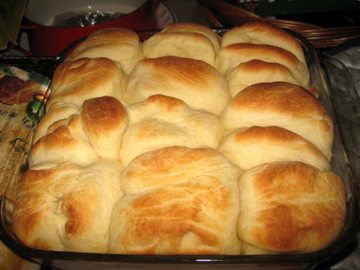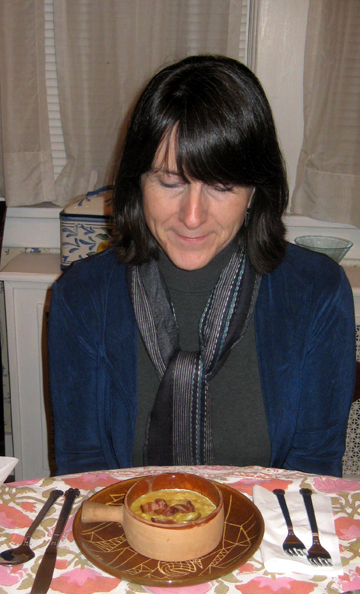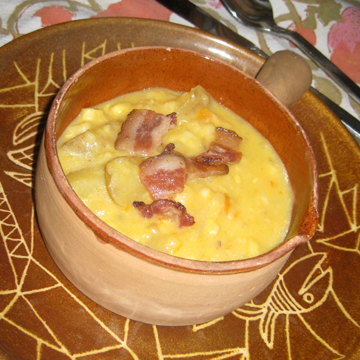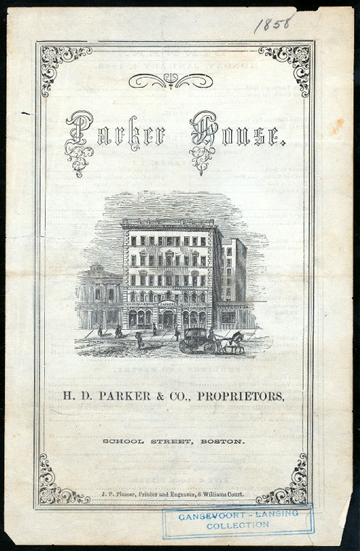
(Courtesy of the New York Public Library)
I didn’t grow up eating Parker House rolls. Indeed, I’m not sure I even saw one until last week when, encouraged by Elizabeth at New England Bloggers, I attempted to make them. My attempt wasn’t perfect—my rolls ended up a little crowded in their pans!—but the end product WAS delicious.
Elizabeth suggested the rolls as a quintessentially New England food. They are certainly steeped in history. They’re also steeped in butter.
Now known as the Omni Parker House, the Parker House is the oldest continuously operating hotel in the United States. This Boston landmark was founded in 1855 by Harvey Parker, a restaurateur who wanted to expand into overnight trade.
The Parker House’s visitors were a who’s who of 19th and 20th century America. Its illustrious Saturday Club met on a weekend afternoon once a month at the hotel beginning in 1855.
Members of this intellectual society included novelist William Dean Howells, naturalist Henry David Thoreau, poet John Greenleaf Whittier, historian Francis Parkman, and other luminaries.
When in town English novelist Charles Dickens was a guest member; he performed his first American reading of A Christmas Carol to the group. In 1867 he wrote in a letter home
I dine today with Longfellow, Emerson, Holmes, and Agassiz. Longfellow was here yesterday. Perfectly white in hair and beard, but a remarkably handsome and notable-looking man.
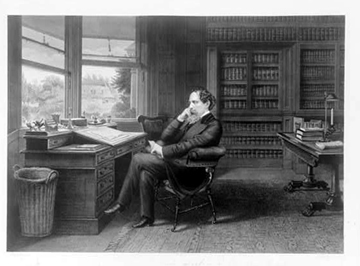
Charles Dickens (Courtesy of the Library of Congress)
Other notable guests included John Wilkes Booth, who came to Boston to watch his brother Edwin perform at the Boston Theater in April 1865 and was observed practicing with his pistol at a nearby shooting gallery; Boston mayor James Michael Curley, the inspiration for the novel The Last Hurrah; more Kennedys than you could fit into a chapel; Bill Clinton; and three of my favorite actresses–Judy Garland, Ann-Margret, and Sarah Bernhardt.
Rather bizarrely, the Parker House employed two noted revolutionaries in their youths, Ho Chi Minh and Malcolm X.
All these people had to be fed, and the elegant Parker House was known for feeding them well. Its kitchen staff invented Boston cream pie, the official dessert of the state of Massachusetts despite the opinion of many that pudding of some sort would be a more appropriate choice.
The Parker House was an early proponent of lemon meringue pie. It was also the place in which the term “scrod” was coined.
And of course it was and is the home of Parker House rolls, invented early on in the hotel’s existence (the Parker House doesn’t seem to have an exact date) by a German baker named Ward who was employed there.
The Parker House roll’s signature is a fold in the middle which gives this small yeast bread its special texture.
In a quick search of cookbooks and the internet I found many recipes for Parker House rolls. They don’t all have as much butter as the formula below. It came from the Omni Parker House web site, however, so it reeks of authenticity as well as butter.
Of course, I changed it a tiny bit—but not much, I promise!
Would I could steal its echoes! You should find
Such store of vanished pleasures brought to mind:
Such feasts! The laughs of many a jocund hour
That shook the mortar from King George’s Tower.
Such guests! What famous names its record boasts,
Whose owners wander in the mob of ghosts!
Such stories! Every beam and plank is filled
With juicy wit the joyous talkers spilled………
Oliver Wendell Holmes, “At the Saturday Club” (1884)
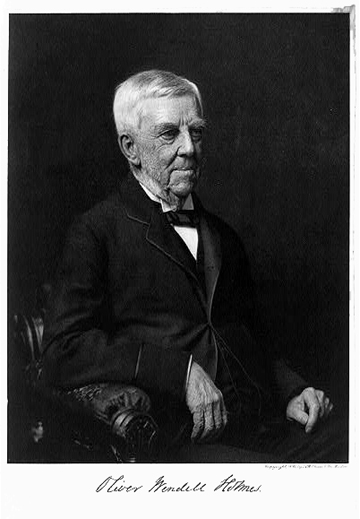
Oliver Wendell Holmes (Courtesy of the Library of Congress)
Parker House Rolls
Ingredients:
6 cups flour (approximately)
1/2 cup sugar
2 teaspoons salt
2 packets yeast (regular “active dry,” not instant)
1 cup milk
1 cup water
1 cup (2 sticks) sweet butter
1 egg
Instructions:
In a large bowl that will work with your electric mixer whisk together 2-1/2 cups flour, the sugar, the salt, and the yeast.
In a small saucepan heat the milk, the water, and 1 stick of the butter until the mixture is the temperature of hot tap water (120 to 130 degrees); your finger should be able to go into it, but it should feel hot. The butter may not be completely melted.
With the mixer at low speed, slowly pour the liquid into the flour mixture. Add the egg and increase the speed to medium. Beat the mixture for 2 minutes, scraping the sides of the bowl as you go along. Beat in 3/4 to 1 cup more flour, enough to make a thick batter. Beat for another 2 minutes.
Turn off the mixer and use a wooden spoon to stir in enough additional flour to make a dough that you can grab as a ball—about 2-1/2 cups.
Move the dough to a floured surface and knead it for 10 minutes, adding flour a little at a time as needed. Shape the dough into a ball and place it in a greased large bowl, turning the dough over so that all sides have touched the grease.
Cover the dough with a damp towel and let it rise in a warm place until it doubles in bulk, 1-1/2 to 2 hours. (The Parker House recommends that you place it in a spot that is 80 to 85 degrees, which may be hard at this time of year; just do your best!) The dough is ready for the next step when two fingers pressed into it leave a dent.
Punch down the dough gently by pushing down the center with your fist; then push the edges of the dough into the center. Turn the dough onto a floured surface, and knead it lightly to shape it into a smooth ball. Cover the ball with your bowl and let it rest for 15 minutes.
Melt the remaining stick of butter and pour it into a large roasting pan (17-1/4 inches by 11-1/2 inches) or divide it between 2 smaller pans. Make sure the butter covers the entire bottom of the pan(s).
On a lightly floured surface with a floured rolling pin roll out the dough until it is 1/2 inch thick. With a floured biscuit cutter cut the dough into circles.
The Parker House recommends 2-3/4-inch circles. My biscuit cutter was missing so I used a 2-inch jar top. I still didn’t have as many rolls as the Parker House says its bakers make; maybe my rolling skills were to blame!
Holding each dough circle by the edge, dip both sides in the butter; then fold each circle in half and place it in the pan. Knead the dough trimmings together and cut more rolls out of them.
Cover the pan(s) with a damp dish towel and let the rolls rise until they double again; this will take 40 minutes to an hour. Toward the end of the rising preheat the oven to 400 degrees.
Bake the rolls for 15 to 18 minutes, until they are brown on top. Remove them from the oven and move them to a rack to dry out a little until you are ready to serve them. If you don’t plan to serve the rolls right away, be sure to warm them again before serving.
Makes between 30 and 40 rolls, depending on your rolling and cutting skills. (The Parker House says 42; I got about 26.)
If you enjoyed this post, please consider taking out an email subscription to my blog. Just click on the link below!
Subscribe to In Our Grandmothers’ Kitchens by Email.



